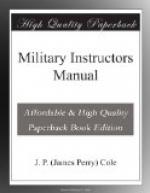The fire must be kept burning for at least ten minutes and the atmosphere in the shelter should be tested from time to time.
Ventilation by Fanning.—Dugouts can be ventilated by producing air currents in them by means of special anti-gas fans.
If no anti-gas fans are available, ventilation can be assisted by flapping with improvised fans such as sand bags, ground sheets, etc.
5. CLEANING OF ARMS AND AMMUNITION:
Rifles and machine guns must be cleaned after a gas attack and then re-oiled. Oil cleaning will prevent corrosion for 12 hours or more, but the first available opportunity must be taken to dismantle machine guns and clean all parts in boiling water containing a little soda. If this is not done, corrosion continues slowly even after oil cleaning and may ultimately put the gun out of action.
After a gas attack, S.A.A. should be carefully examined. All rounds affected by gas must be replaced by new cartridges immediately and the old ones cleaned and expended as soon as possible.
All hand and rifle grenades exposed to the gas should have their safety-pins and working parts cleaned and re-oiled.
All bright parts of light trench mortars, together with all accessories and spare parts exposed to the gas, must be cleaned and wiped dry as soon as possible after the attack and in any case within 24 hours, after which they should be thoroughly coated afresh with oil. The same applies to ammunition which may have been exposed to the gas.
Ammunition which, for any reason, had not been oiled, must be cleaned and oiled and expended as soon as possible.
For details regarding the cleaning of guns and artillery ammunition and signal equipment, see paragraphs 116 and 123.
6. TREATMENT OF SHELL HOLES:
In the neighborhood of shelters or battery positions where gas from shell holes is causing annoyance, the holes and the ground round them should be covered with at least a foot of fresh earth. Shell holes so treated should not be disturbed, as the chemical is not thereby destroyed and only disappears slowly.
Concealment From Aerial Observers.
A. 1. An aeroplane cannot conduct reconnaissance
at a height of less
than 5,000 feet
without being within easy range of
anti-aircraft
artillery; nor of less than 2,000 feet without
coming into range
of machine-gun and rifle fire.
2. To be observed from such
heights, objects on the ground must be
distinguished
by:
(a)
Motion.
(b)
Color contrast.
(c)
Line contrast, or
(d)
Shadows.
B. Concealment:
1. (a) On warning of hostile aircraft,
troops on the march should
withdraw
to the side of the road (if possible, into shade),
or
lie down flat in the road and remain motionless.
(b) If it is necessary




